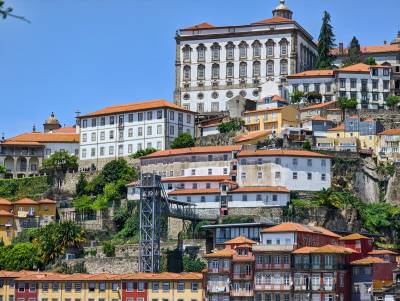Praia Castelo do Queijo translates to "Cheese castle beach"! The name actually comes from the Fort of São Francisco Xavier which overlooks the beach. It is said that the fort was built on a rock that resembled an enormous piece of cheese.
The beach itself is a short stretch of sand and rocks which backs onto a promenade. Not generally as popular as Matasinhos around the corner the beach still gets busy during the summer months
Portugal’s second city sits along the Atlantic coastline in the north of the country, making it slightly less hot than more southerly destinations. Its historic centre is a UNESCO World Heritage Site and is one of the oldest, best preserved historic cities in Europe. So when is the best time of year to visit?
Its location right next to the Atlantic actually makes Porto one of the wetter cities in Europe, but it also receives plenty of sunshine throughout the year, on a par with Mediterranean cities such as Rome and Barcelona. The rainfall is not evenly spread throughout the year....


The Palácio da Bolsa (Stock Exchange Palace) in Porto was built to impress. Whilst it is no longer the centre of trade in Porto it still doesn't fail to impress. When the palace was built in the 1840s Porto was a thriving city. In order to compete with other European cities the merchant's association of Porto decided to create a lavish building that would be the city's commercial hub.

The fairly austere and imposing cathedral in Porto (Sé do Porto) was mostly built during the 12th and 13th centuries in the Romanesque style. However, it didn't really reach completion until the 16th century and even after this it was considerably remodelled and extended in the Baroque style.
Occupying the high ground to the east of the city, the cathedral looks westwards over the historic centre. From its commanding position the church does have something of a feel of a fortress about it - particularly the crenelations which run around the building, somewhat reflecting the...
Still standing tall on Porto's skyline is the iconic Baroque bell tower and church of Clerigos. Rising over 75 metres from its already elevated position this slender granite tower was the tallest building in Porto when it was built in 1763. In fact it was not until 1999 that this was surpassed with the construction of the Hotel Vila Galé Porto.
Situated only a short walk from the Ribeira and in Porto's historic centre this is by far the finest church. The Igreja de São Francisco (Church of St Francis) dates back to the 14th century when it was built as an enlargement to an existing church connected to the Franciscan convent. Constructed in the Gothic style the exterior is fairly modest compared to some of the Manueline excess of this period seen elsewhere. However, all this restraint is thrown to the wind when it comes to the interior.
The former residence of the bishops of Porto is built in a late baroque and rococo style and is believed to be the work of Italian architect Nicolau Nasoni

Aquarium featuring a variety of underwater environments from freshwater streams to the rugged coastlines, long sandy beaches to deep ocean. Species include sharks, jellyfish and seahorses
The Monument to the Heroes of the Peninsular War site in the middle of the large rotunda in the Boavista district of Porto. Despite being in the middle of a busy round-a-bout the monument is set in a peaceful tree-lined garden.
The monument celebrates the Portuguese and British victory against the French forces of Napoleon during the 1808-1814 Peninsular War. Set atop the impressive column is a lion, representing the Portuguese and British, dominating an eagle, representing the forces of Napoleon





